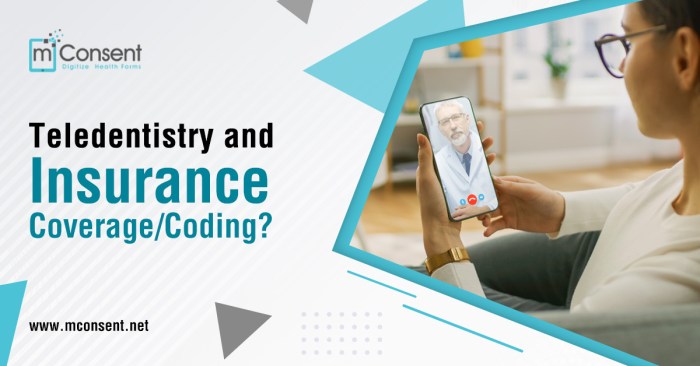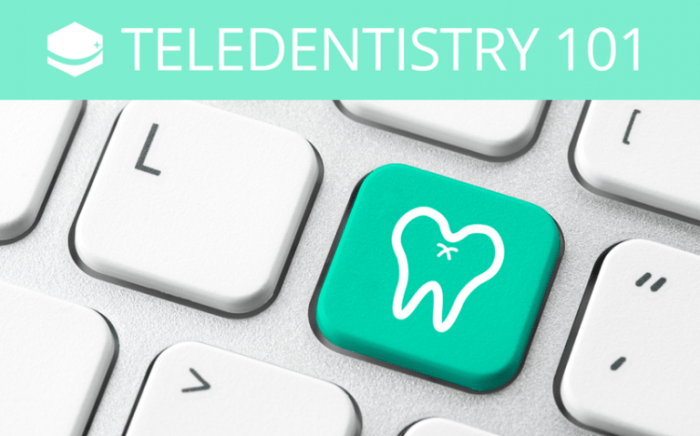
As Teledentistry insurance coverage takes center stage, this opening passage beckons readers into a world crafted with good knowledge, ensuring a reading experience that is both absorbing and distinctly original.
Teledentistry combines modern technology with dental care, allowing patients to consult with dental professionals remotely. This innovative approach is particularly relevant in today’s fast-paced world, as it enhances access to dental services while also raising questions about insurance coverage. Understanding how teledentistry is integrated into insurance plans is crucial for patients seeking comprehensive dental care options.
Understanding Teledentistry Insurance Coverage

Teledentistry is an evolving field that enhances dental care by utilizing digital communication technology. It allows patients to receive dental consultations, diagnoses, and treatment plans from the comfort of their homes. As this practice grows, understanding how it interacts with insurance coverage becomes essential for both patients and providers.Teledentistry services are increasingly recognized by insurance companies, reflecting the shifting landscape of healthcare delivery.
Many insurance plans now include provisions for teledentistry, ensuring that patients can access necessary dental care remotely. Coverage often encompasses virtual consultations, follow-up appointments, and certain diagnostic procedures. However, specifics can vary significantly between plans, making it important for patients to review their individual insurance policies.
Differences Between Traditional Dental Insurance and Teledentistry Insurance Coverage
The coverage structure of teledentistry differs from traditional dental insurance in several key aspects. Understanding these distinctions can help patients navigate their options effectively.
- Service Delivery: Traditional dental insurance typically covers in-person visits and procedures, while teledentistry insurance focuses on remote consultations and digital interactions.
- Reimbursement Rates: Insurance plans may offer different reimbursement rates for teledentistry services compared to conventional dental services, potentially leading to out-of-pocket costs for patients.
- Eligible Procedures: Some insurance providers limit the procedures that can be billed as teledentistry. Commonly covered services include initial assessments and follow-ups, but complex procedures might still require in-person visits.
- Technology Requirements: Teledentistry often necessitates specific technology or platforms for service delivery, which may impact coverage if not utilized properly.
- Network Limitations: Some policies may restrict teledentistry services to in-network providers, whereas traditional dental coverage may allow more flexibility in provider choice.
“As teledentistry evolves, understanding the nuances of insurance coverage becomes crucial for accessing quality dental care.”
Navigating teledentistry insurance requires awareness of these differences. Patients should engage with their insurance representatives to clarify coverage details, ensuring they can make informed decisions regarding their dental health.
Comparison of Dental Insurance Types

Understanding the differences between standard dental insurance and teledentistry insurance options is crucial for patients seeking effective ways to manage their dental health. Traditional dental insurance typically covers in-person procedures, while teledentistry introduces a modern approach that leverages technology to expand access to dental care. This comparison will highlight the implications of integrating teledentistry within conventional dental insurance frameworks, as well as the potential benefits and limitations associated with policies that include teledentistry services.
Differences in Coverage
Standard dental insurance generally provides coverage for a range of in-office dental services, including routine check-ups, cleanings, fillings, and more complex procedures such as root canals or crowns. On the other hand, teledentistry insurance options focus on remote consultations, diagnosis, and follow-up care, which can help address dental issues without the need for an in-person visit. Here are some aspects to consider:
- In-Person Services: Traditional coverage typically includes preventive care, basic procedures, and emergency services performed by a dentist in their office.
- Remote Consultations: Teledentistry may cover virtual visits, where patients can consult with dental professionals via video calls or mobile apps, allowing for convenient diagnosis and treatment advice.
- Emergency Care: While standard plans often ensure immediate access to emergency dental care, teledentistry can help in triaging urgent issues and providing quick guidance on whether an office visit is necessary.
Implications of Teledentistry in Traditional Frameworks
Integrating teledentistry services into existing dental insurance policies presents both opportunities and challenges. It allows for a more flexible approach to dental care, particularly in underserved areas where access to traditional dental professionals is limited. However, there are implications to consider:
- Expanded Access: Patients can receive timely care without geographic limitations, which is particularly beneficial for those living in remote locations.
- Policy Adjustments: Insurance providers may need to revise their coverage policies to incorporate teledentistry, ensuring they meet regulatory standards and patient needs.
- Quality of Care: The effectiveness of teledentistry relies heavily on technology and the ability of patients to communicate their issues accurately, which can vary significantly among individuals.
Benefits and Limitations of Teledentistry Coverage
Policies that include teledentistry services can significantly enhance patient care by providing convenience and accessibility. However, there are both advantages and limitations to consider:
- Benefits:
- Convenience: Patients can attend appointments from the comfort of their home, saving time and reducing travel expenses.
- Cost-Effective: Teledentistry can potentially lower overall costs associated with in-office visits, making dental care more affordable.
- Prevention Focus: Regular virtual check-ins can promote ongoing dental health management and early intervention for potential issues.
- Limitations:
- Diagnosis Limitations: Certain conditions may require physical examinations or tests that cannot be performed via telehealth.
- Technology Barriers: Not all patients may have access to the necessary technology or internet connectivity for effective teledentistry.
- Insurance Variability: Coverage for teledentistry can vary widely among insurance providers, leading to confusion about what services are included.
“Teledentistry expands access to care while presenting unique challenges that must be navigated for effective integration into existing coverage models.”
Related Insurance Types and Their Impact on Dental Care
Understanding the interplay between various insurance types is essential for grasping how they can influence access to dental care, particularly through teledentistry. Each type of insurance, whether directly related to dental services or not, can shape the experiences and opportunities available to patients seeking care.
Impact of Disability Insurance on Access to Dental Care
Disability insurance plays a significant role in determining access to dental care and teledentistry services. Individuals who rely on disability insurance may find their options limited by the terms of their coverage. For example, many disability policies provide income replacement but may not extend to dental treatments, resulting in a dual burden for those needing oral health care. This limitation affects not only the individual’s ability to pay for traditional dental visits but also their access to teledentistry services, which can often be more convenient and affordable.
Additionally, the integration of teledentistry can offer flexible access to care, especially for individuals with mobility issues or those who may find it challenging to attend in-person appointments. However, if their disability insurance does not recognize or cover teledentistry, these patients may still face barriers in utilizing this innovative service.
Relationship between Health Insurance and Dental Insurance in Teledentistry
The relationship between health insurance and dental insurance is crucial, particularly when it comes to teledentistry. While health insurance generally covers medical services, dental insurance specifically addresses oral health care. Many individuals have separate policies, which can lead to confusion regarding coverage when accessing teledentistry.When teledentistry services fall under the umbrella of dental insurance, patients often benefit from lower out-of-pocket costs.
However, if a patient’s health insurance includes oral health provisions, it may be possible to access certain dental services through their health plan, offering additional options. This relationship underscores the importance of understanding both policies to maximize coverage and minimize expenses.For instance, a patient with a health insurance plan that includes dental benefits may utilize teledentistry for consultations related to oral health issues that are symptomatic of broader health concerns, thus benefiting from both insurance types.
Indirect Influence of Flood Insurance on Dental Providers and Teledentistry
Flood insurance, while not directly related to dental care, can indirectly impact the operations of dental providers and their ability to offer teledentistry services. Dental practices situated in flood-prone areas often face significant infrastructure challenges during and after flood events. These challenges may include temporary closures, damage to equipment, and disruptions in service delivery. In such scenarios, having flood insurance can help dental providers recover more swiftly, allowing them to restore services, including teledentistry.
This capability ensures that patients continue to receive care even when physical offices are compromised. Furthermore, dental practices that successfully navigate flood-related disruptions are likely to maintain their patient base and potentially attract new patients who value the accessibility of teledentistry during emergencies.In summary, while flood insurance does not directly relate to dental care, it plays a vital role in ensuring that dental providers can sustain operations and adapt their services to meet patient needs in times of crisis.
Outcome Summary
In summary, the exploration of teledentistry insurance coverage highlights the evolving landscape of dental care. As patients and providers embrace this new approach, understanding the nuances of insurance options will empower individuals to make informed decisions about their dental health. With teledentistry, the future of accessible dental care is bright, making it an exciting time for patients and insurers alike.
Question Bank
What is teledentistry?
Teledentistry is the use of digital technology to provide dental care remotely, allowing patients to consult with dentists through video calls or other online platforms.
Does insurance cover teledentistry services?
Coverage for teledentistry services varies by insurance provider, but many plans are beginning to include these services as a part of their coverage options.
Are there limitations to teledentistry coverage?
Yes, limitations may include restrictions on certain services that require in-person visits, or specific conditions that need to be met for coverage to apply.
How does teledentistry affect traditional dental insurance?
Teledentistry can complement traditional dental insurance by providing additional options for consultations and follow-ups, potentially increasing access to care.
Can I get a prescription through teledentistry?
Yes, dentists can prescribe medications during a teledentistry consultation if deemed necessary, although this may vary depending on regulations and the dentist’s discretion.





